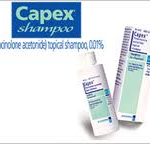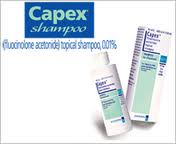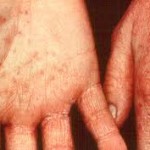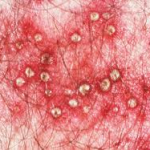If HPA axis suppression is noted, an attempt should be made to withdraw the drug, to reduce the frequency of application, or to substitute a less potent corticosteroid. Infrequently, signs and symptoms of glucocorticoid insufficiency may occur requiring supplemental systemic corticosteroids. For information on systemic supplementation, see prescribing information for those products.
 Pediatric patients may be more susceptible to systemic toxicity from equivalent doses due to their larger skin surface to body mass ratios.
Pediatric patients may be more susceptible to systemic toxicity from equivalent doses due to their larger skin surface to body mass ratios.
If irritation develops, Capex® Shampoo should be discontinued and appropriate therapy instituted. Allergic contact dermatitis with corticosteroids is usually diagnosed by a failure to heal rather than noting a clinical exacerbation as with most topical products not containing corticosteroids. Such an observation should be corroborated with appropriate diagnostic patch testing.
If concomitant skin infections are present or develop, an appropriate antifungal or antibacterial agent should be used. If a favorable response does not occur promptly, use of Capex® Shampoo should be discontinued until the infection has been adequately controlled.
Information for Patients: Patients using topical corticosteroids should receive the following information and instructions:
1. This medication is to be used as directed by the physician. It is for external use only. Avoid contact with the eyes. In case of contact, wash eyes liberally with water.
2. This medication should not be used for any disorder other than that for which it was prescribed.
3. The treated scalp area should not be bandaged or otherwise covered or wrapped so as to be occlusive unless directed by the physician.
4. Patients should report to their physician any signs of local adverse reactions.
5. Discard contents after three (3) months.
Laboratory Tests: The following tests may be helpful in evaluating patients for HPA axis suppression.
- ACTH stimulation test
- A.M. plasma cortisol test
- Urinary free cortisol test
Carcinogenesis, mutagenesis, and impairment of fertility: Long-term animal studies have not been performed to evaluate the carcinogenic potential or the effect on fertility of Capex® Shampoo.
Pregnancy: Teratogenic effects: Pregnancy category C: Corticosteroids have been shown to be teratogenic in laboratory animals when administered systemically at relatively low dosage levels. Some corticosteroids have been shown to be teratogenic after dermal application in laboratory animals.
There are no adequate and well-controlled studies in pregnant women or teratogenic effects from Capex® Shampoo. Therefore, Capex® Shampoo should be used during pregnancy only if the potential benefit justifies the potential risk to the fetus.
Nursing Mothers: Systemically administered corticosteroids appear in human milk and could suppress growth, interfere with endogenous corticosteroid production or cause other untoward effects. It is not known whether topical administration of corticosteroids could result in sufficient systemic absorption to produce detectable quantities in human milk. Because many drugs are secreted in human milk, caution should be exercised when Capex® Shampoo is administered to a nursing woman.
Pediatric Use: Safety and effectiveness in children and infants have not been established. Because of a higher ratio of skin surface area to body mass, pediatric patients are at a greater risk than adults of HPA axis suppression when they are treated with topical corticosteroids. They are therefore also at a greater risk of glucocorticoid insufficiency after withdrawal of treatment and of Cushing’s syndrome while on treatment. Adverse effects including striae have been reported with inappropriate use of topical corticosteroids in infants and children.
HPA axis suppression, Cushing’s syndrome and intracranial hypertension have been reported in children receiving topical corticosteroids. Manifestations of adrenal suppression in children include linear growth retardation, delayed weight gain, low plasma cortisol levels and absence of response to ACTH stimulation. Manifestations of intracranial hypertension include bulging fontanelles, headaches and bilateral papilledema.
ADVERSE REACTIONS: The following local adverse reactions have been reported infrequently with topical corticosteroids. They may occur more frequently with the use of occlusive dressings, especially with higher potency corticosteroids. These reactions are listed in an approximate decreasing order of occurrence: dryness, folliculitis, acneiform eruptions, perioral dermatitis, allergic contact dermatitis, secondary infection, skin atrophy, striae, miliaria, burning, itching, irritation, and hypopigmentation.
OVERDOSAGE: Topically applied Capex® Shampoo can be absorbed in sufficient amounts to produce systemic effects.
DOSAGE AND ADMINISTRATION: The pharmacist must empty the contents of the enclosed capsule into the shampoo base prior to dispensing to the patient. This product should be shaken well prior to use. No more than approximately one (1) ounce of the medicated shampoo should be applied to the scalp area once daily, worked into a lather, and allowed to remain on the scalp for approximately 5 minutes. The hair and scalp should then be rinsed thoroughly with water.
HOW SUPPLIED: Capex® Shampoo is supplied as a two component package: a capsule which contains the active component fluocinolone acetonide 0.01%, and a separate package of liquid shampoo. The pharmacist must mix the content of the capsule into the base at the time of dispensing. Capex® Shampoo is dispensed to the patient in a 6 ounce bottle.
Shake well before using.
Store between 15° and 30° C (59° and 86° F) in tightly closed containers.


